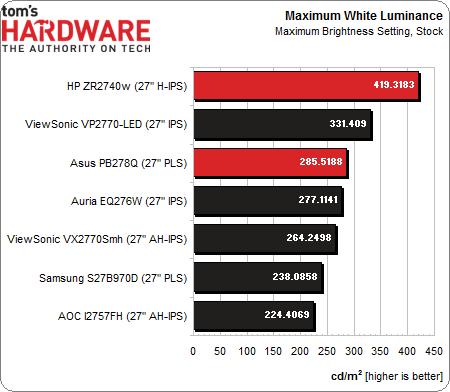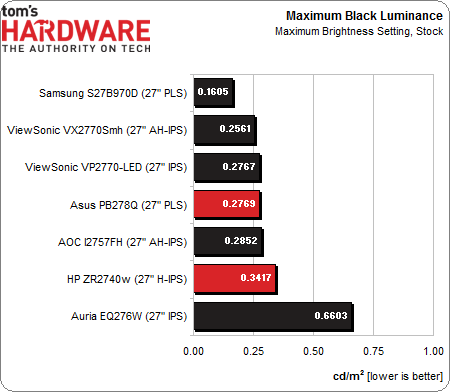HP ZR2740w Versus Asus PB278Q: QHD 27" Monitors, Tested
Until cutting-edge UHD (3840\00d72160) displays hit the mainstream, most enthusiasts have to be content with QHD monitors at 2560x1440 pixels. In the lab today, we have two more 27-inch QHD screens: the ZR2740w from HP and the PB278Q from Asus.
Results: Stock Brightness And Contrast
Before calibrating the two panels, we measure zero and 100 percent signals at both ends of the brightness control range. This shows us how contrast is affected at the extremes of a monitor's luminance capability.
Both screens are very bright, but the HP exceeds its own spec by almost 40 cd/m2. Fortunately, color and gamma are largely unaffected by maxing the brightness. So, should you actually need over 400 cd/m2 of light output, the ZR2740w can surely deliver. The Asus is near the top of the pack with over 286 cd/m2 available.
With so much output on tap from the HP, let’s see how black levels are affected.
Both panels are very well-engineered in that they can maintain a decent black level at maximum output. You can see how cranking the brightness affects the Auria’s black level more negatively than the other screens. The Samsung remains the undisputed leader in this test.
Topping out the brightness slider is usually not the way to achieve a good contrast ratio, since black levels rise right along with the peak number. Better-designed screens can buck this trend to some degree.
The HP ZR2740w comes within striking distance of the contrast-leading Samsung S27B970D. And the Asus PB278Q is not too far behind, either. For any panel to measure over 1,000:1 in native contrast is excellent performance. Even at max settings, both monitors deliver a nice, punchy image with plenty of depth and detail.
Not all monitors are practical for use at the minimum brightness setting. We consider 50 cd/m2 to be a realistic lower limit for viewing in a totally-darkened room.
Get Tom's Hardware's best news and in-depth reviews, straight to your inbox.
Here, the Asus stays above the 50 cd/m2 mark, but the HP falls a good bit short. At 27 cd/m2, the ZR2740w’s picture is dim enough to cause eyestrain during extended use. A few clicks of the brightness button can bring the image to a usable level. This is made a bit more difficult thanks to the lack of an on-screen menu or even a level indicator. You have to set the level by eye, so it’s practically impossible to hit the same mark every time you make a change.
The fun part about bottoming out the brightness control is seeing how low the black level becomes. Even though it’s not completely realistic, some panels achieve absurdly low numbers.
The HP ZR2740w is the new king of the minimum black level test. In fact, we had to average several readings because we neared the limit of our spectrophotometer’s measurement capability. Just remember that the HP is too dim to be used for extended periods at these settings. The Asus and both ViewSonic monitors do produce a usable image at their respective minimum brightness settings, yet still manage to crank out a very low black level. If you increase the HP’s brightness to 50 cd/m2, the black level only rises to 0.0462 cd/m2, which is still excellent performance.
Along with low black levels come extremely high contrast ratios.
Once again, the HP nips at the Samsung’s heels at 3,346.2 to 1. The Asus takes up a firm position in the middle, with a very respectable 1,215.6 to 1.
No matter what the brightness setting, both monitors produce excellent contrast. You can use them at any light level you desire and still enjoy nice contrast, for an image with plenty of depth and pop.
Current page: Results: Stock Brightness And Contrast
Prev Page Measurement And Calibration Methodology Next Page Results: Calibrated Brightness And Contrast
Christian Eberle is a Contributing Editor for Tom's Hardware US. He's a veteran reviewer of A/V equipment, specializing in monitors. Christian began his obsession with tech when he built his first PC in 1991, a 286 running DOS 3.0 at a blazing 12MHz. In 2006, he undertook training from the Imaging Science Foundation in video calibration and testing and thus started a passion for precise imaging that persists to this day. He is also a professional musician with a degree from the New England Conservatory as a classical bassoonist which he used to good effect as a performer with the West Point Army Band from 1987 to 2013. He enjoys watching movies and listening to high-end audio in his custom-built home theater and can be seen riding trails near his home on a race-ready ICE VTX recumbent trike. Christian enjoys the endless summer in Florida where he lives with his wife and Chihuahua and plays with orchestras around the state.
-
KOKing I've had one of these HPs at work for a couple of months (replacing an early 24" 1920x1200 IPS), which I've set fairly low), but as this review says, it's not really necessary. I was a little disappointed that, possibly because of the aspect ratio change to 16:9, it doesn't _feel_ like a lot more screen real estate.Reply -
SIDDHARTH MISHRA Useless review, the uniformity on these screens is pathetic, tried three of each, the color temp difference across the screen is over 1000K. Toms has very poor reviewers, only prad.de and overclockers.ru do reliable screen reviews. And btw the U2713HM is regularly on sale for $500 or so, the ZR2740W is now an overpriced relic lacking even an OSD.Reply -
cangelini SIDDHARTH MISHRAUseless review, the uniformity on these screens is pathetic, tried three of each, the color temp difference across the screen is over 1000K. Toms has very poor reviewers, only prad.de and overclockers.ru do reliable screen reviews. And btw the U2713HM is regularly on sale for $500 or so, the ZR2740W is now an overpriced relic lacking even an OSD.Screen uniformity is covered on page eight, and low points on both screens are discussed.Reply -
flong777 Am I right by saying that the Asus monitor has more accurate color and better grayscale performance.Reply -
Marcus52 Surprised that the Asus has slightly better lag results, as one of the reasons for not having an OSD is to reduce lag, and it can make a big difference. Of course, how you measure lag can get different results, and I've seen much lower numbers for the ZR2740w:Reply
http://www.tftcentral.co.uk/reviews/hp_zr2740w_v2.htm
tftcentral is showing the HP as having far less lag than the Asus panel. -
ceberle The Asus certainly calibrates better than the HP; mainly because it can be calibrated. The HP is slightly better out of the box for grayscale and its chromaticity is also a touch better. Both screens have identical color to the eye. Only the instruments can tell the difference.Reply
Christian -
ceberle Regarding the lag results: It's hard to compare numbers from one review to another when the testing methods are so different. With our high-speed camera procedure, the only fair comparison is between the monitors we've tested. I would defend our response test as definitive though. Actually watching the screen draw in slow motion leaves no room for interpretation. The lag test is also consistent since we use the same signal chain for every screen. There is never a change in video cards, drivers, peripherals or any other device that might affect the result.Reply
Christian -
dgingeri I have the HP ZR2740w, and have for over a year now. It's a great looking monitor, and it performas well by my standards, but suffers from a significant lack of both reliability and support. HP's support is massively fragmented. It took me over three hours on the phone to get to the department that actually handled the support for this monitor. (It is a "Commercial" monitor, not business or personal. It's splitting hairs mighty thin, but that's the way HP's support is separated out.) When I finally got through, they sent a tech with a replacement monitor the next day. However, it also has two major hardware issues that render it useless when they occur. Most of the first run monitors had the power supplies die within months. The second run monitors had a serious issue with the control boards. All of them have issues with the USB hub, but it least the monitor keeps working if you don't have the USB cable plugged in. As an owner of one, I would not, under any circumstances, recommend this monitor to anyone.Reply
HP: the perfect example of a company falling apart because it is both too big and too fragmented.





